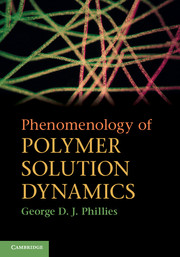Book contents
- Frontmatter
- Contents
- Preface
- 1 Introduction
- 2 Sedimentation
- 3 Electrophoresis
- 4 Quasielastic light scattering and diffusion
- 5 Solvent and small-molecule motion
- 6 Segmental diffusion
- 7 Dielectric relaxation and chain dimensions
- 8 Self- and tracer diffusion
- 9 Probe diffusion
- 10 Dynamics of colloids
- 11 The dynamic structure factor
- 12 Viscosity
- 13 Viscoelasticity
- 14 Nonlinear viscoelastic phenomena
- 15 Qualitative summary
- 16 Phenomenology
- 17 Afterword: hydrodynamic scaling model for polymer dynamics
- Index
- References
7 - Dielectric relaxation and chain dimensions
Published online by Cambridge University Press: 05 August 2012
- Frontmatter
- Contents
- Preface
- 1 Introduction
- 2 Sedimentation
- 3 Electrophoresis
- 4 Quasielastic light scattering and diffusion
- 5 Solvent and small-molecule motion
- 6 Segmental diffusion
- 7 Dielectric relaxation and chain dimensions
- 8 Self- and tracer diffusion
- 9 Probe diffusion
- 10 Dynamics of colloids
- 11 The dynamic structure factor
- 12 Viscosity
- 13 Viscoelasticity
- 14 Nonlinear viscoelastic phenomena
- 15 Qualitative summary
- 16 Phenomenology
- 17 Afterword: hydrodynamic scaling model for polymer dynamics
- Index
- References
Summary
Introduction
A characteristic feature of many molecules and chemical bonds is an electric dipole moment whose orientation is substantially fixed as viewed in internal molecular coordinates. Dielectric spectroscopy observes the temporal evolution of net polarization induced in these dipole moments by an applied electrical field. It was first noted by Stockmayer(1) that polymer chain dipoles may be grouped into three classes, namely: (A) dipoles that point along the polymer backbone, so that in the simplest cases the dipoles are relaxed by (i) reorientation of the polymer end-to-end vector r, and (ii) breathing modes that changes the vector's length; (B) dipoles that point perpendicular to the polymeric backbone, so that they are relaxed via crankshaft-like motions of the backbone; and (C) dipoles associated with polymeric side groups that are relaxed via rotation of the side groups around the bond axis linking the side groups to the backbone. Type-A dipoles may be in turn divided into two classes, namely (i) polymers in which the dipolar units are linked head to tail, so that the total dipole vector and the end-to-end vector are necessarily linearly proportional, and (ii) polymers in which the dipole is associated with only part of the polymeric repeat unit, so that the total dipole vector and the end-to-end vector may fluctuate with respect to each other. Class C dipoles generally relax the most quickly, while class A dipoles relax the most slowly.
- Type
- Chapter
- Information
- Phenomenology of Polymer Solution Dynamics , pp. 134 - 170Publisher: Cambridge University PressPrint publication year: 2011



